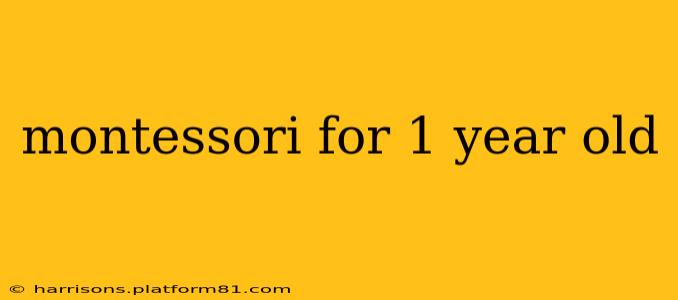Montessori education, renowned for its child-centered approach, offers a unique and enriching experience for even the youngest learners. While traditional schooling might seem distant for a one-year-old, the Montessori method focuses on fostering independence, exploration, and practical life skills from the earliest stages of development. This article will delve into what a Montessori environment for a one-year-old looks like, addressing common questions parents often have.
What is a Montessori environment for a 1-year-old like?
A Montessori classroom for toddlers is meticulously designed to be a safe, engaging, and stimulating space tailored to their developmental needs. Everything is scaled down to their size, making materials accessible and encouraging self-sufficiency. Expect to find low shelves filled with carefully chosen activities designed to enhance various skills. These activities might include:
- Practical life exercises: Simple tasks like pouring, scooping, washing (with child-safe materials), and dressing themselves. These exercises build fine motor skills, hand-eye coordination, and independence.
- Sensorial materials: Toys that stimulate different senses, such as textured fabrics, nesting cups, and color-coded cylinders. These activities aid in sensory discrimination and cognitive development.
- Language materials: Picture cards, simple books, and toys that encourage language development. Singing and storytelling are also vital components.
- Movement and mobility: Lots of space to move around freely and explore, promoting gross motor skills and physical development.
What activities are suitable for a 1-year-old in a Montessori setting?
Montessori education at this age focuses on building foundational skills through play. Here are a few examples of activities you might see:
- Practical Life: Transferring objects from one container to another using spoons, tongs, or scoops. Washing dolls or small toys. Learning to open and close containers. Putting on and taking off simple clothing items like socks.
- Sensorial: Exploring different textures by touching various fabrics. Matching shapes and sizes with nesting blocks. Sorting objects by color or size. Working with water pouring activities (under supervision).
- Language: Reading simple books with repetitive phrases. Singing songs and rhymes. Naming objects during play. Engaging in simple conversations.
How do Montessori principles apply to 1-year-olds?
The core Montessori principles remain consistent across all age groups. For one-year-olds, this translates to:
- Freedom of Choice: Children are allowed to choose the activities that interest them, fostering self-directed learning.
- Prepared Environment: The classroom is carefully designed to support the child’s development and make learning accessible.
- Auto-education: Children learn at their own pace through self-directed exploration and discovery.
- Sensitive Periods: The Montessori approach recognizes specific periods in a child’s development when they are particularly receptive to learning certain skills. The curriculum is designed to capitalize on these sensitive periods.
Are there any differences between a Montessori classroom and a daycare for 1-year-olds?
While both provide childcare, the approach to learning differs significantly. Montessori classrooms emphasize independent learning and hands-on activities designed to build specific skills, while daycares might offer more unstructured play and less focus on structured learning activities. The environment itself also differs, with Montessori classrooms often being more carefully planned and organized.
How can I create a Montessori-inspired environment at home for my 1-year-old?
You can incorporate Montessori principles at home by creating a safe and stimulating environment with age-appropriate materials. This includes:
- Low shelves: Make toys and materials accessible to your child.
- Organized space: Keep things tidy and organized so your child can easily find what they need.
- Natural materials: Choose toys and materials made from natural materials whenever possible.
- Practical life activities: Incorporate simple chores like helping set the table or watering plants.
- Unsupervised play time: Allow your child to engage in self-directed play in a safe space.
By understanding the core principles of Montessori and adapting them to your home, you can provide your one-year-old with a rich and nurturing learning environment that fosters independence, curiosity, and a love of learning. Remember that consistency and patience are key to successfully implementing a Montessori approach at home.
